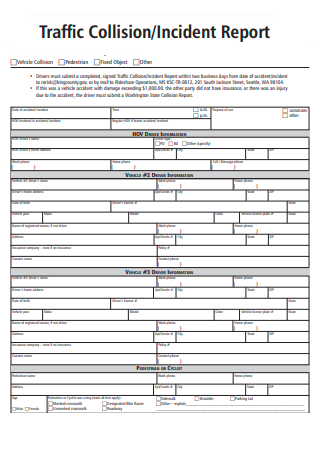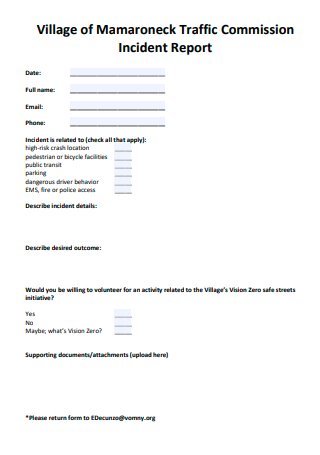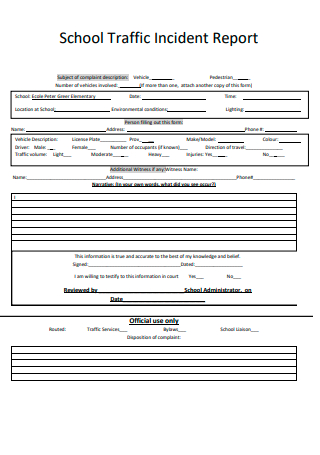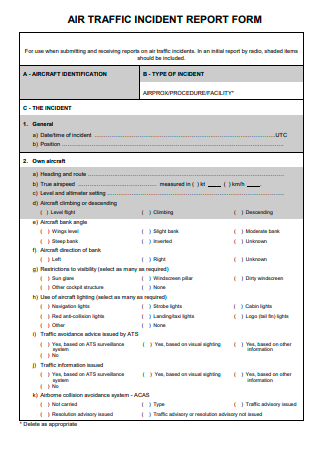4+ Sample Traffic Incident Report
FREE Traffic Incident Report s to Download
4+ Sample Traffic Incident Report
What Is a Traffic Incident Report?
Common Causes of Car Accidents
Tips for Composing a Good Incident Report
How to Write a Traffic Incident Report
FAQs
What is an accident investigation?
What is the main difference between an incident report from a police report?
What is the purpose of reporting an incident?
What Is a Traffic Incident Report?
A traffic accident is recognized as an accident involving at least one vehicle on a public road that results in at least one person being hurt or killed. An Incident Report is a formal document that describes the circumstances surrounding a specific area’s occurrence. Together, a traffic incident report is a written report from a recent incident to analyze and develop an action plan to address it. The road traffic incident report should be written and submitted right after an instance of the incident or injury for an immediate initial investigation. Checking out the traffic incident report sample could help you get a clearer picture of the structure.
Common Causes of Car Accidents
An automobile collision might have a number of unintended effects, such as lasting injuries, loss of employment, and so on. Why not do everything you possibly can to prevent getting into a vehicle accident in the first place? Some personal injury law firms would want to assist you in understanding the primary causes of Vehicle accidents, and thus assist you in learning preventative measures for vehicle accidents on the road. While some of these automobile accident reasons may seem apparent and repetitious to seasoned drivers, this list is intended to educate all levels of drivers to provide a more factual vehicular accident investigation report.
Tips for Composing a Good Incident Report
Incident Reports are a critical component of the health and safety routine. In order to complete an incident report document that adds value to your company, site, or organization, you must include all necessary facts. An incident report must contain all pertinent details concerning the accident or near-miss. The report-writing process starts with gathering facts and finishes with suggestions for avoiding future mishaps. You may utilize a particular incident reporting form, which could be extremely detailed. This curated list will help to remind you of what characteristics a report must have to be considered good.
How to Write a Traffic Incident Report
The first portion of practically every traffic incident report form serves as the repository for administrative information. This information is quite constant, regardless of the kind of event report. Other data may be included in certain event reports for specific objectives, but the content should stay reasonably consistent. The goal is to identify the Report, its author, as well as the place, date, and time of the occurrence. You may collect the essential data by using checklists or police traffic incident report templates that have been provided by the site to ensure no relevant steps have been skipped over.
1. Gathering the Information
In coming up with a traffic crash incident report, the initial step is to gather all pertinent information. This provides all of the incident’s information, such as when it happened, where it happened, what happened, and how many people were affected. Approach the conscious victim, witnesses, bystanders, or anyone in direct vicinity that could recount the events of the incident. You should also provide any relevant images or video proof as this can help in providing evidence of what had transpired throughout the course of the incident.
2. Set the Order of Events
Once you have gathered all of the facts concerning an occurrence, you must establish what precisely occurred. A successful incident report begins with a narrative of what happened, followed by a chronological account of each occurrence. The sequence of events is critical because it aids investigators in determining whether there is a pattern to the problem and how to resolve it. Keep in mind that this step is not possible with missing information from the incident which could cause the investigators to assume different scenarios instead.
3. Determine the Root Cause
After discovering the full flow of Events in which the incident happened, you must investigate the underlying cause of the problem in order to develop solutions to avoid such situations in the future. The study may also involve a review of earlier instances that were comparable in character and frequent to the current one. This can assist you to determine whether or not there is a common cause for all of these instances. Finding out what is causing this incident, whether it was the first time it happened or a repeating instance, is helpful to create a solution to address it.
4. Formulate Corrective Action
After determining the core cause of the incident, you may work together to develop remedial or Preventative measures to avoid a similar incident in the future. Instead of assumptions or guesses, these remedial measures should be based on prior experiences and lessons gained. You can also incorporate other team members or stakeholders who may be knowledgeable about preventing such situations in the future. All of this information will aid the investigating team in determining what went wrong and making suggestions.
FAQs
What is an accident investigation?
Accident investigations demonstrate the need for safety programs in every firm. Finding the fundamental causes of accidents helps in identifying measures to prevent the same accident from happening again. Accidents are examined by on-the-scene supervisors and professional safety specialists with relevant expertise. Accident investigators and well-equipped teams are available in some companies to address the aftermath of Accidents. These individuals have the necessary training and expertise to conduct an accident investigation. Some businesses additionally employ unique accident reporting templates that include fundamental causes as well as remedies. A thorough study may reveal some contributory elements and suggest many preventative actions.
What is the main difference between an incident report from a police report?
These two concepts are frequently regarded as synonymous. The primary distinction, though, is who completes it. A police report, as the name implies, is complete documentation of a crime written by an officer or other representative of a police agency who was present at the crime scene. An incident report, on the other hand, can be prepared by anybody, as previously said, who wishes to record any incidents that may or may not have caused harm to someone or anything. A police report necessitates an investigation, but an incident report can be utilized as a supporting document to an inquiry or event analysis.
What is the purpose of reporting an incident?
The goal of incident reporting is to chronicle an occurrence, assess its potential cause, document any measures that have done and notify stakeholders. An incident report can be used to help with an event’s investigation and analysis. It contains the core cause as well as corrective activities to reduce the Risks involved and prevent such occurrences in the future. Incident reports can also be utilized as safety documentation, indicating possible dangers and uncontrolled hazards discovered on the job site. The practice of documenting all job site injuries, near misses, and accidents is known as incident reporting. No matter how slight the injury, an incident report should be prepared at the time of the event.
Preparing a traffic accident incident report will require time in collecting information and writing out the actual report before it undergoes thorough investigation and actualization of the concrete action plan to address the incident. Though if it has been a recurring incident, then ample information has been collected and all it needs is time to come up with a solution to decrease it from happening again. What are you waiting for? Write and prepare a traffic incident report now and help lessen society from encountering common nuisances!





